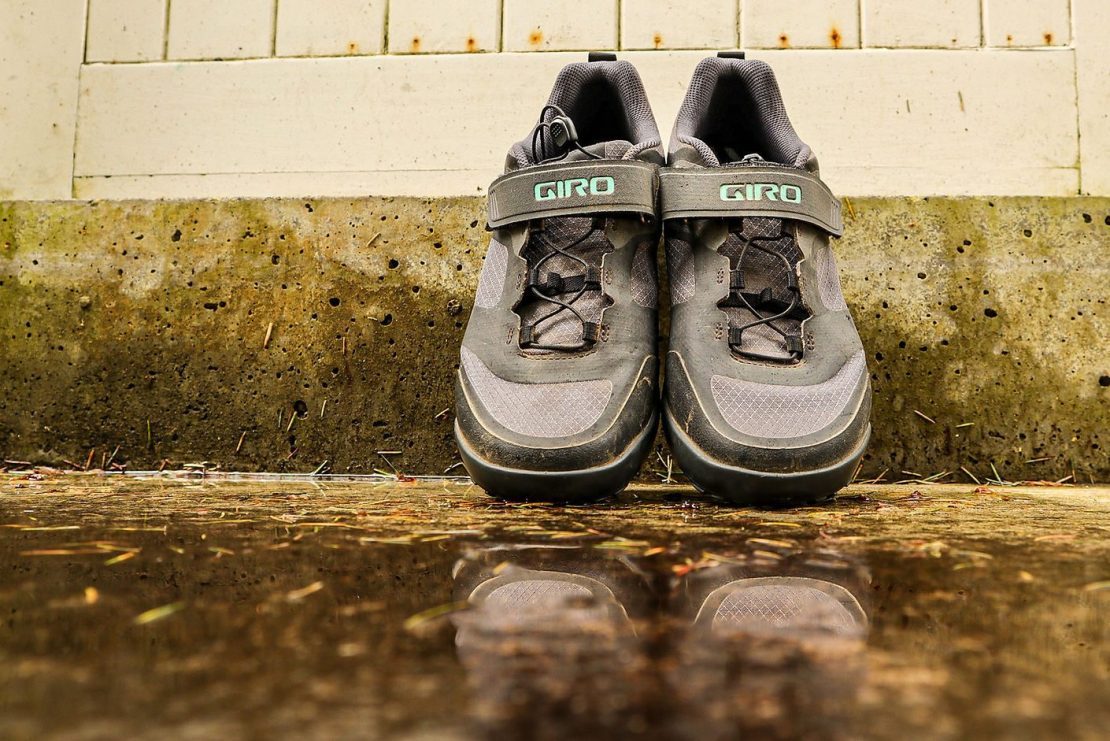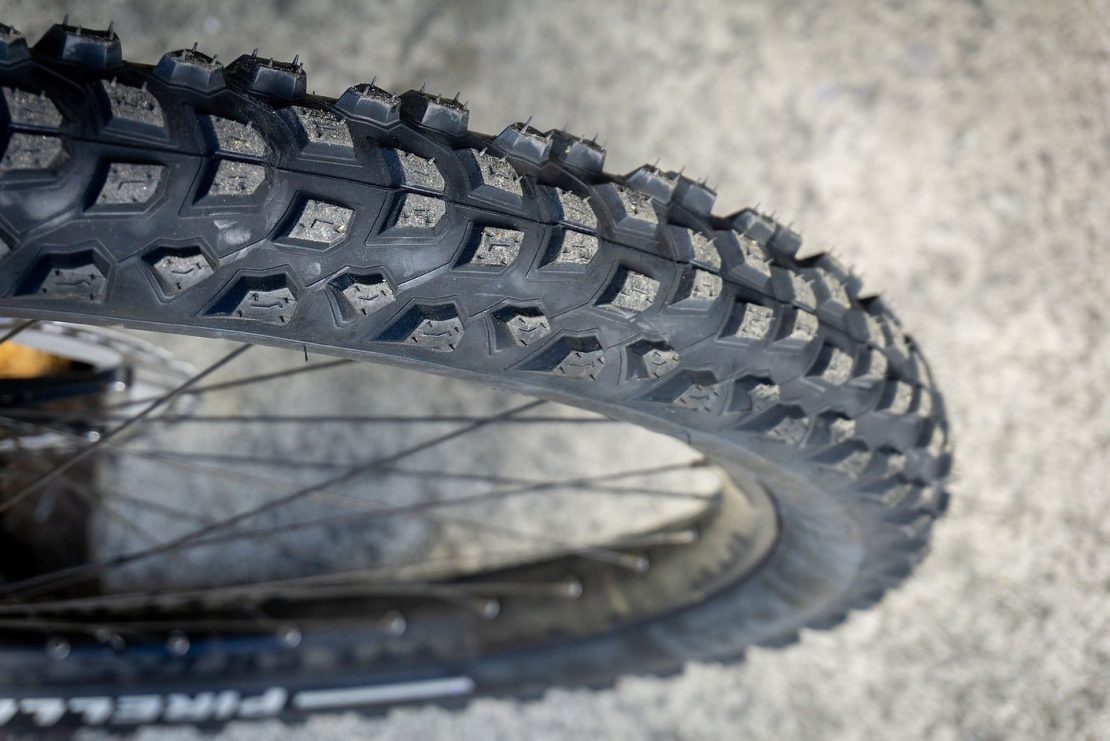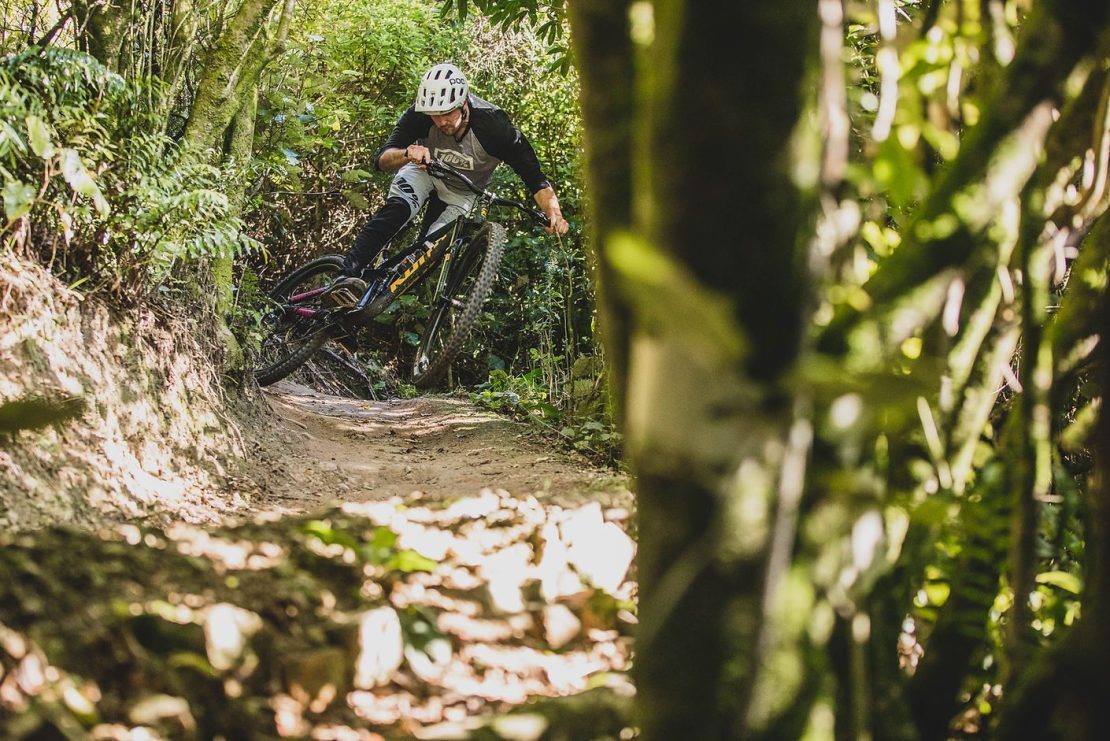Review: Norco Torrent
Hardtails. It’s where we all started. Whether it was a Raleigh 20, a PK Ripper, or a 90s Diamondback, almost universally we all started shredding on a hardtail bike of some description.
However, with the wave of decent full suspension bikes coming to market from the 2000s onwards, most regular mountain bikers have moved to a full suspension bike being their usual trail machine. Despite this, the diehards have remained - outliers; trolling us on their nimble single speeds; others cajoling us on their 26” wheeled fluro-accented 90s machine, with clothing to match; and the odd hardcore XC racer, rolling up on the starting line. Some even manage to hit the trifecta and achieve a higher level of consciousness by occupying the Venn centre of those three circles in one sweet rigid moment. But, if you thought for a moment you didn’t fit any of those categories - you like gears and on-trend fashion, and have no interest in racing - the good news is there is still a place in hardtail nirvana for you. The mountain bike industry is always on the hunt to be able to provide exactly what you are looking for and, as such, a new category has emerged in the last few years that caters to those who might like the aggressive riding characteristics of a slack full suss, but without some of the drawbacks such as extra cost, maintenance and lack of pumping ability.
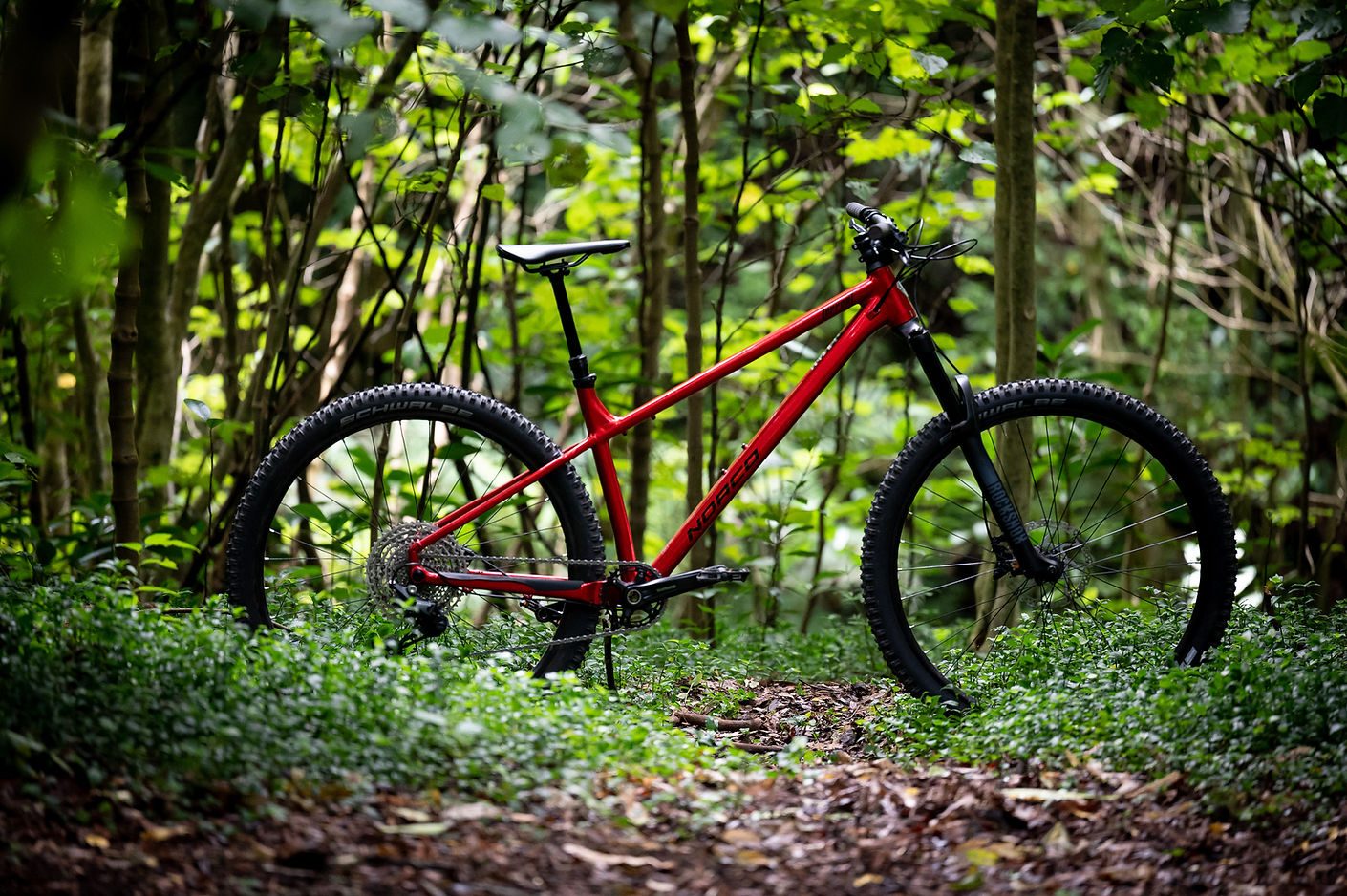
The new Norco Torrent is one of these bikes - and we’ve had the chance to spend some time reviewing it. The Torrent comes in two frame materials (steel or alloy) and at two price points for each frame. The A2 comes in at $2499, the A1 (tested) at $2999, the S1 at $3299, and the flagship S1 at $4499. The steel frame is also available as a frame only for $1099. Like most bikes in the current climate, stock is extremely limited so you may have to ring around a few shops before you are able to get your hands on one.
First off, yes, it’s true - and now officially, scientifically proven in the NZ Mountain Biker laboratory - red goes faster, and therefore this Torrent is damn near flying. It’s got that same kind of wow factor that made your eyes pop out of your head when you unwrapped your first bike on Christmas day. You can’t help but smile at this bike. And, maybe that’s a bit of a clue as to what this bike is all about; hardtails have a way of harking us back to simpler times, before we began obsessing about what difference five psi might make, tokens in our shocks, and if a nitrogen fill would actually make us faster. No. hardtails force the rider to remove themselves from any such trivialities, name them for what they are (“bull s%*t”) and let their own riding skills stand for themselves…. Or not. It’s an approach to riding that is both freeing, and terrifying.
But enough waxing poetic. What is the new Torrent all about? Well, in the case of aggressive hardtails, it’s all about the numbers, and numbers that have been usually associated with that mad friend you grew up with who was always putting an insanely long travel fork on his hardtail (eventually he snapped his headtube right?) but, damn, he could ride. We all had a friend like that. Well, maybe that mad friend was on to something, because the aggressive hardtail category is now a real thing.
So, let’s start with a few of the features of the Torrent. First up, on the A1 we’ve got the 150mm travel RockShox 35 Gold fork, that’s matched to a 64 degree head angle. By way of example, the Norco Sight, a bike aimed at EWS/Enduro riders, has a head angle of 63.5, so that’s the kind of territory you are in. Our large has a 480mm reach, 76 degree seat tube, and a 425mm rear centre (chainstays). These numbers might not mean a whole lot to you but for a hardtail they are right down the aggressive end of the spectrum.
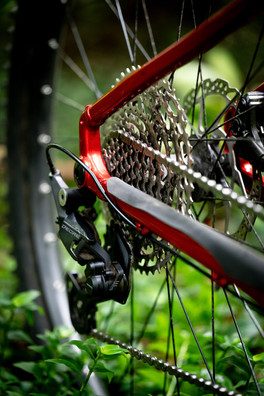
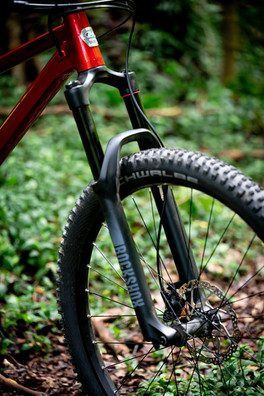


The Torrent is rolling on Stans Flow D 29” rims, (pre-taped, and with Stan’s valves and sealant in the box we got this rolling tubeless in about 10 minutes) with Schwalbe Hans Dampf rubber. In the drivetrain, the Torrent gets the value oriented new Deore 12 speed 10-51 1x drivetrain. And lastly, keeping things under control, are the Shimano 4-pot 420 brakes. You also get a Trans-X 150mm dropper and a Fizik Taiga saddle all for $2999.
After a relatively simple build, it was out into the streets for a quick rolling check and feel. Instantly, the thing that popped out to me was how similar to my last long travel full suspension bike this Norco felt in terms of overall position in the cockpit. Nice wide 800mm bars, and that visual cue of where the front wheel sits out in front of the stem - it all felt like it was trying to mirror the experience of a long travel full suspension bike in terms of rider body position. A great start!

Out on the trail and the thing that hardtails beg you to do is get up out of the saddle and sprint. Every little climb, every little straight, you know that any effort you put in is rewarded with instant acceleration. Caution, you may start referring to your full-suss bikes with phrases like ‘Mr Blobby’ or other such names, because this thing just wants to go. But any hardtail can say that. The thing with the Torrent, is that it wants to keep going faster when the trail turns down. If you’ve moved from an XC oriented hardtail to a more trail oriented full suss (a pretty normal progression in bike ownership) you might not be aware how much geometry and tyre choice factored into the feeling of confidence that your new long travel bike has given you. That’s what the Torrent has tapped into here. All those things that make modern full suspension bikes great, but in a hardtail package. So, when the trail turns a bit techy, gets a bit of flow, or you see a few jumps, whoops, opportunities to manual etc, you don’t for a moment think “darn I wish I was on my full suss bike so I could enjoy this bit of trail” - you just rad on through it!
Of course, there are limitations to this. Firstly, decent size jumps. No matter how good your technique is, unless you are riding perfectly sculpted dirt jumps, you’ll still be coming back down to earth with a fairly decent impact on a hardtail. There is no way to avoid this, but good technique can make it the best version of what it is - you and a hunk of metal hitting the earth at 30 km/hr. On the plus side, knowing this is imminent, and also knowing you’ve got new abilities to accelerate quickly as you approach the takeoff, you might actually find yourself clearing jumps you didn’t before, and focusing more on your actual jumping technique. For better or worse, this bike won’t hide anything. If you can jump well, you will jump well on the Torrent, if you can’t - and you need your squish to cover your poor technique or habit of always landing on the knuckle - the Torrent won’t save your ass from your poor technique.

But the sweet spot for the Torrent is surprisingly large. On singletrack that isn’t insanely rough, has twists and turns and built in flow, you’ll be surprised just how good it feels. In fact, if you know how to pump, you’ll be reminded of just what you give up by going to a full suss bike in this area. A flowy singletrack trail with lots of rolling undulations and opportunities to make speed through pumping is what this bike was made for, and you’ll be surprised just how fast you might find yourself going as you use the trail to create speed - and that is a real smile inducing way to ride.
We would love to test the steel frame version to see if we could really ‘feel’ the fabled compliance of steel vs alloy, but the reality is the 150mm of suspension and chunky tires are going to absorb most of that, so it might be hard to argue for the steel option based on performance. However, we also know steel bikes are just their own version of sexy - and you’ll get extra street cred to boot - but alongside that, they also have great qualities in terms of fatigue resistance (think of all the big hits you’re giving this thing!) so, in saying that, for an extra $300 the entry level steel model might just be our pick of the bunch.
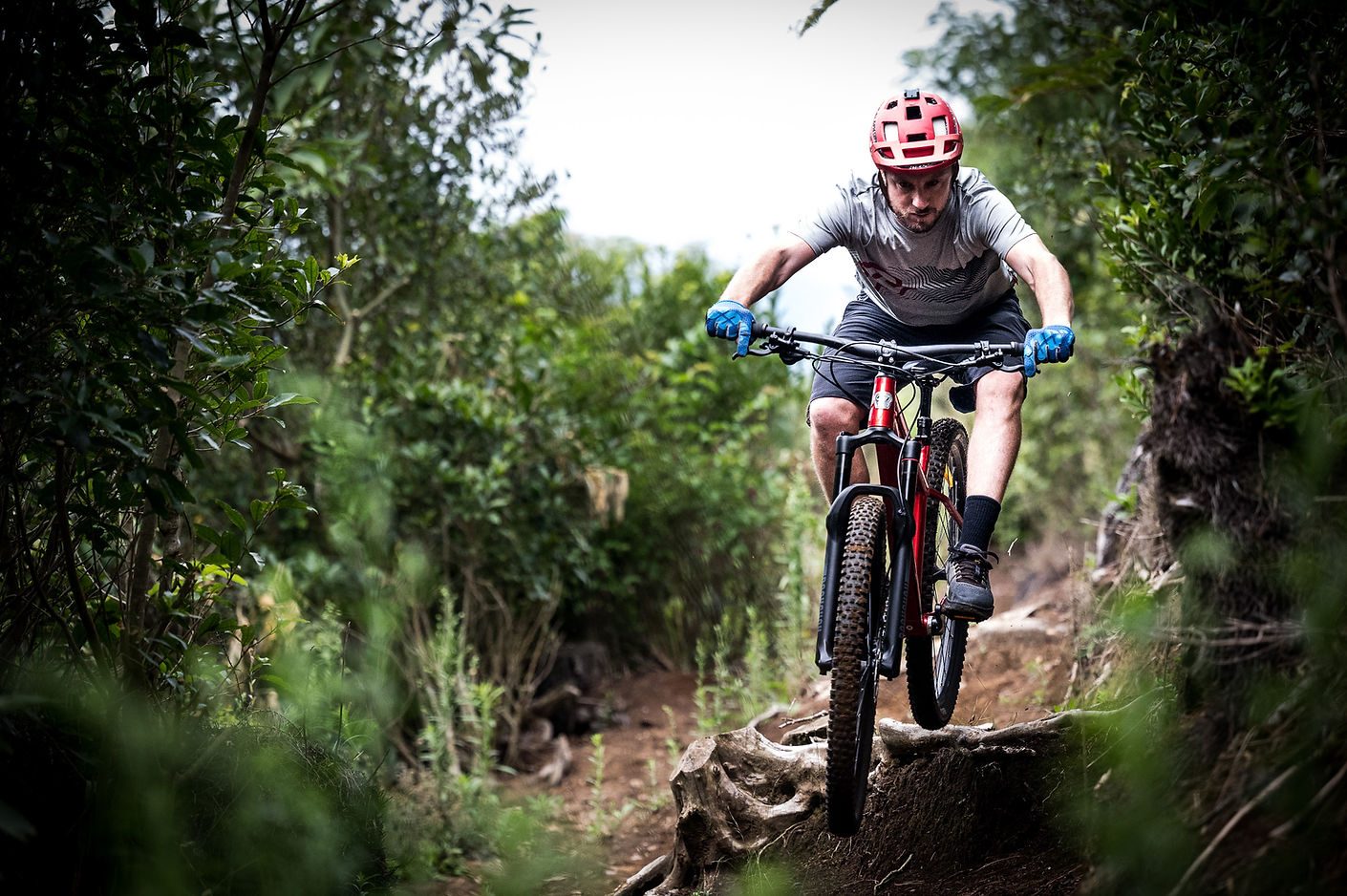
Despite being impressed overall, there were a few minor things that didn’t quite work out. The internal cable routing rattled, the Fizik seat just didn’t seem to fit our bottom shape, and though thin grips seem all the rage, these ones seemed just a bit too thin and were really just kind of hard. Those are all pretty minor changes though.
The spec on the A1 model we tested was the no frills option, and that helps keep the price under $3k, but it doesn’t mean there is a lot we’d change. In fact, the 12 speed Deore groupset is sublime. You also get Shimano hubs as opposed to some non-branded cost saving option, and the Stans rims held up well to the abuse we put them through. The 420 Shimano 4-pot brakes don't have quite the same refined lever shape or overall shininess of their higher priced siblings, but they don’t lack for power either. When you need to drop the anchors, they do the job just fine. Speaking of the jumps and drops you’ll be wanting to do on this, it’s when you start to trust the geometry and ride with more and more confidence that you also realise the limitations of the 35 Gold fork. It doesn’t have the damping refinements of it’s more expensive brethren such as the Pike or Lyrik, which is a shame as you have to go all the way up to the $4499 top spec model to get a better fork. It’s not that the fork isn’t up to handling itself with big hits, it's just that it's a simpler damping system all together. This means that to get the sensitivity on the small impacts you lose some of the control at managing the big impacts, which is a shame, as getting rowdy is what this bike is built for. Of course, the simple solution is; if you’re focusing on riding rowdy, set it up accordingly and it will take care of you just fine. Switching out a fork isn’t as easy as switching out the grips, but if this bike had something like a Pike on it, we think it would have been a home run.
All in all, the Norco Torrent is an impressively fun bike to ride, with a solid component package that will impress you with just what modern hardtails are really capable of. It’s not for the dirt jumpers nor the hucksters, it’s a trail bike that will go anywhere and everywhere and make you wonder why you’ve been carrying that saggy rear shock around with you for so long.
Distributed by Advanced Traders | RRP: $2,899
Words: Lance Pilbrow
Images: Julia Moore-Pilbrow
Review: Giro Ventana Women's FastLace Shoe
It had been a while since I’d ridden my MTB. Throw in shoulder surgery rehabilitation and COVID, and you have exactly six months. Needless to say, I needed all the flare and sparkle a new pair of shoes could bring me. ‘This ain’t gonna be pretty’, I thought to myself as we ran the gauntlet that is South Auckland traffic, and escaped to Whakarewarewa, Rotorua. Pooch, hubby, bike, not to mention the new kicks – sorted!
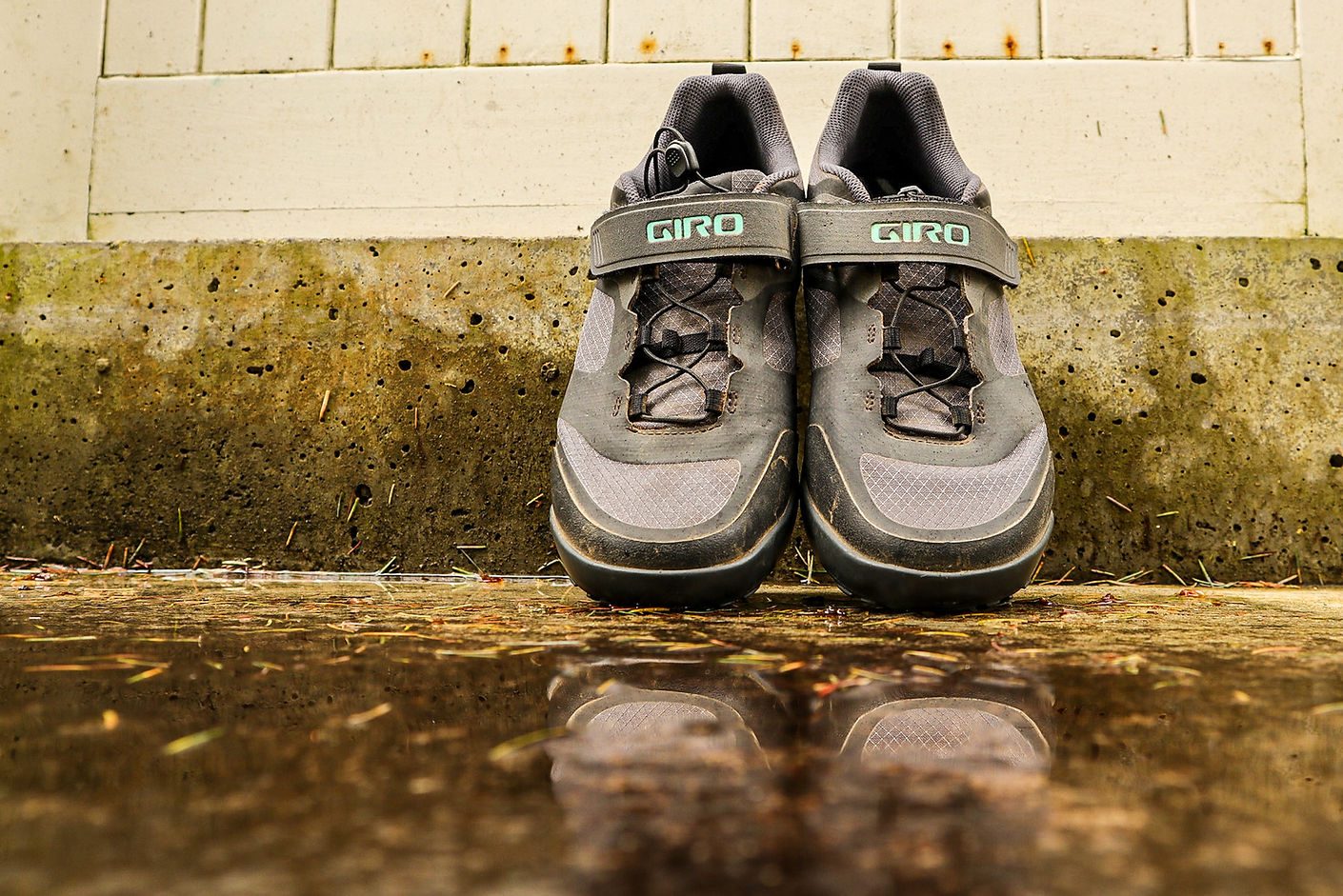
With my head full of noise about how my shoulder was going to hold up, I didn’t need foot drama added to the mix – so I was literally comforted with the secure, snug fit when I first got into the shoes. These shoes gave me the support and responsiveness of a more rigid XC shoe, with the comfort you need when having to do a bit of hiker-bike. After a lot of time working from home in my Ugg boots, my feet were happy with a bit of cushion and support provided by the moulded Eva footbed.
We gave the pooch a bit of a run around before we headed out onto the trails, at the great dog park on Long Mile. Being out of my usual rhythm a bit, I had forgotten to bring dog walking shoes, so ended up walking the pooch pre-ride in my new MTB shoes. Now that’s one way to wear them in – no issues at all I must add – impressive!
By the time we headed out onto the trails it was still pretty fresh and my hands were still cold. This is where the Fastlace system came into its own; with minimal effort I was able to pull the laces tight with the pull cord and lock them into place, creating a super snug fit. The laces could then be easily tucked away behind the Velcro strap across my ankle. Like any good Rotorua day, the weather heated up pretty nicely out on the trails. This lace system allowed simple easing off of the tension as my feet got a bit warmer and needed a bit more space.
On a couple of techy parts on the trails, I lost my nerve a bit and needed to dismount and scoot myself and the bike down a tricky downhill section. I was really confident in the Ventana, they gave me great grip as I edged my way down the drop off (‘next time I’ll nail it!’). Like many other readers, I’m sure, I am pretty hard on my shoes – let’s blame it on our genes. Riding the trails that day, I felt confident in the durability of these shoes. It must be something to do with the Giro Sensor Rubber and Synchwire feature on the outer part of the shoe, which says: ‘Show me the roughest terrain – no matter what, I’ve got you’. These shoes tell me they will go the extra mile and more.
This shoe has that effortless flat kick look, can step up to the starting plate for a speed effort or could go all day - and the next - with minimal impact. What’s more, they can transition from the trails into the local Te Arawa Seafood store for some fresh scallops (shout out to Te Arawa Seafoods!) with ease.
Distributed by Worralls | RRP: $229
Reviewed by Philppa Friary
Review: Pirelli Scorpion eMTB Tyres
A lot of new players are entering the mountain bike tyre market of late, bolstering the choices we have in a sector that has been dominated by one or two brands for many years. The names coming in though are not unrecognisable, and have plenty of experience in the rubber game in auto and moto applications, and are applying that knowledge to their mtb offerings. Pirelli, the Italian brand steeped in racing history across all forms, have thrown their hat in the ring and the Scorpion series is their flagship tyre for aggressive trail riding, enduro racing and e-mtb. After some of our testers had put in time on the Scorpions on regular mtbs, I got hold of the E version for some boosted riding.

Emtbs have particular requirements when it comes to tyres, namely large volume, chunky treads and sturdier casings. The Scorpions come with a thick sidewall dubbed Hyper Wall, that isn't really explained beyond that on their website. Whatever they've done works, as I dropped pressures as low as 15PSI, with the sidewalls still feeling solid and without any squirm whatsoever under hard cornering. The front 2.6 EMTB-S tyre has massive knobs spaced well apart, and the side knobs take the bite factor to the next level with their size and toothy profile digging into anything from loose over hardpack to mud and slimey rocks. Just looking down and seeing that big boy leading the way instils some false bravado, and when you get a bit carried away with the speed it'll quickly step in to correct things as you try to wrestle the bike back on line.

Out back there's the EMTB-R, with the same 2.6 Hyper Wall casing and Smart Grip compound (another Italian mystery that uses something called Lignin, look it up) but in a way less aggressive rear tread pattern. Tighter spaced knobs in the centre help with braking and more importantly traction, especially important if you're one to take on steep technical ups as well as downs. Wheelspin even on rutted out goat racks was negligible until the gradient got too much more for the rider than the bike. Smaller side knobs make it easy to drift the rear wheel as far as you like in corners, knowing that when you want some grip it'll be there. To say the Scorpions changed the way my bike rode would only be half the story, as the confidence they give changed the way I rode the bike too.
The set-up was painless and the tyres have held air well between rides. After around 100km of trail riding and a sniff of tar, the knobs are holding up well and look like they'll be around for a long time, as well as a hell of a gripping good time.
Distributed by FE Sports | RRP: $137
Review: 100% Accuri 2 Goggles
I was never sure why goggles were a requirement in mountain biking, but they are certainly in many rider’s kits these days. I fully understand, from my motocross days, that they stop the roost from a wildly spinning rear tyre being fired into your eyes at the speed of a bullet… but mountain bikes don't do that. Moto riders hit speeds that blur the vision and water the eyes… but mountain bikers don't usually do that. Sure, we can wear specific riding glasses to take care of those concerns, but rarely have I thought I need to wear goggles when mountain biking. After receiving a 100% Trajecta full-face helmet and these Accuri 2 goggles to review, I was interested to see if mind could be changed.
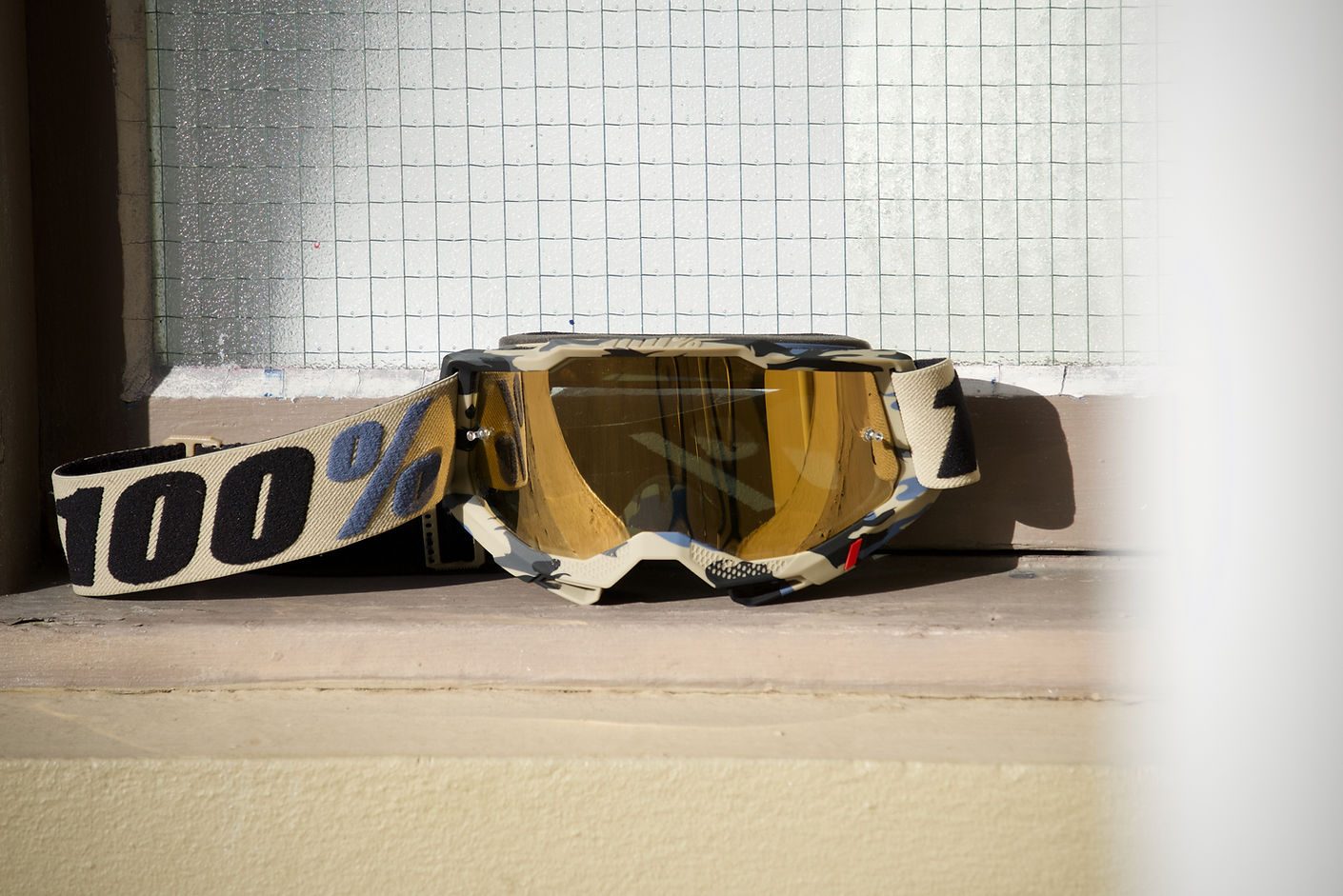
There’s no denying goggles offer better eye protection than glasses, but do we really need them? From listening to other riders, and wading through the swamp of all-knowing online forums, I discovered that a big part of it isn't just function, but fashion too. Apparently, it's not cool to wear riding glasses with a full-face helmet but, somehow, it is cool to wear goggles with a half-shell. Whack. I need to wear prescription lenses when riding, as I can't tolerate contact lenses, so whether I'm wearing a full-face or a half-shell, I really have no choice but to wear glasses. Yes, there are prescription lenses available in a number of goggles, and 100% does offer this option, but it's very expensive – especially if you need several tints for varying conditions.
So, I tried the glasses with goggles method. Wearing goggles while climbing isn't the most comfortable or should I say, breathable, especially on a slowbike (MTB). It's a little more practical if climbing on a fastbike (EMTB), but I still found that removing the goggles and slinging them around the back of my neck – while wearing my prescription riding glasses – was the better option, especially on warmer days. If the goggles are to be used for downhill sections, they have to fit over my glasses. These Accuri 2 units, despite not being a specific OTG (Over The Glasses) model, do that well. As long as there was some air flow, I didn't fog up with the double-up option, probably as the polycarbonate lens has an anti-fog treatment that lives up to its claims. 100% do offer the Accuri 2 in a OTG model, which I hope to try out, to maximise fit and function even more.

The lens my test pair came with is a reflective True Gold tinted number, and it did a good job of reducing glare on some late afternoon rides with low sun. A clear lens is also available (I think it's usually included, but ours didn't come with it). The 45mm wide strap has a silicon gripper which kept it firmly in place on the helmet, while triple-layer foam soaked up the sweat well and felt good against the skin, with no movement or irritation at all. Meanwhile, the vents did a good job of keeping condensation away.
If nothing else, wearing goggles does give you a sense of impenetrable eye protection, and a full-moto vibe, which I'm all about! I still need to figure out the ‘whys’ and ‘hows’ of it all, so cut me some slack if I'm carrying three helmets, two sets of glasses and these excellent goggles on my next ride. I'd hate to be in the wrong kit for a particular section or type of ride. Then again, perhaps I'll just put protection first, pretend I'm Cooper Webb, and give the fashionistas the middle finger.
Distributor: FE Sports
Words and Images: Brett Kennedy
Review: 100% S2 Sunglasses
In the past, cycling glasses haven’t appealed to me, but I was excited to try out the 100% S2 sunglasses when given the opportunity. After using them for the past five weeks, I'm seldom seen without them. After the signing of Peter Sagan, the popularity of 100% eyewear grew exponentially. They now offer an extensive range which covers all aspects of performance, protection, and prescription glasses.
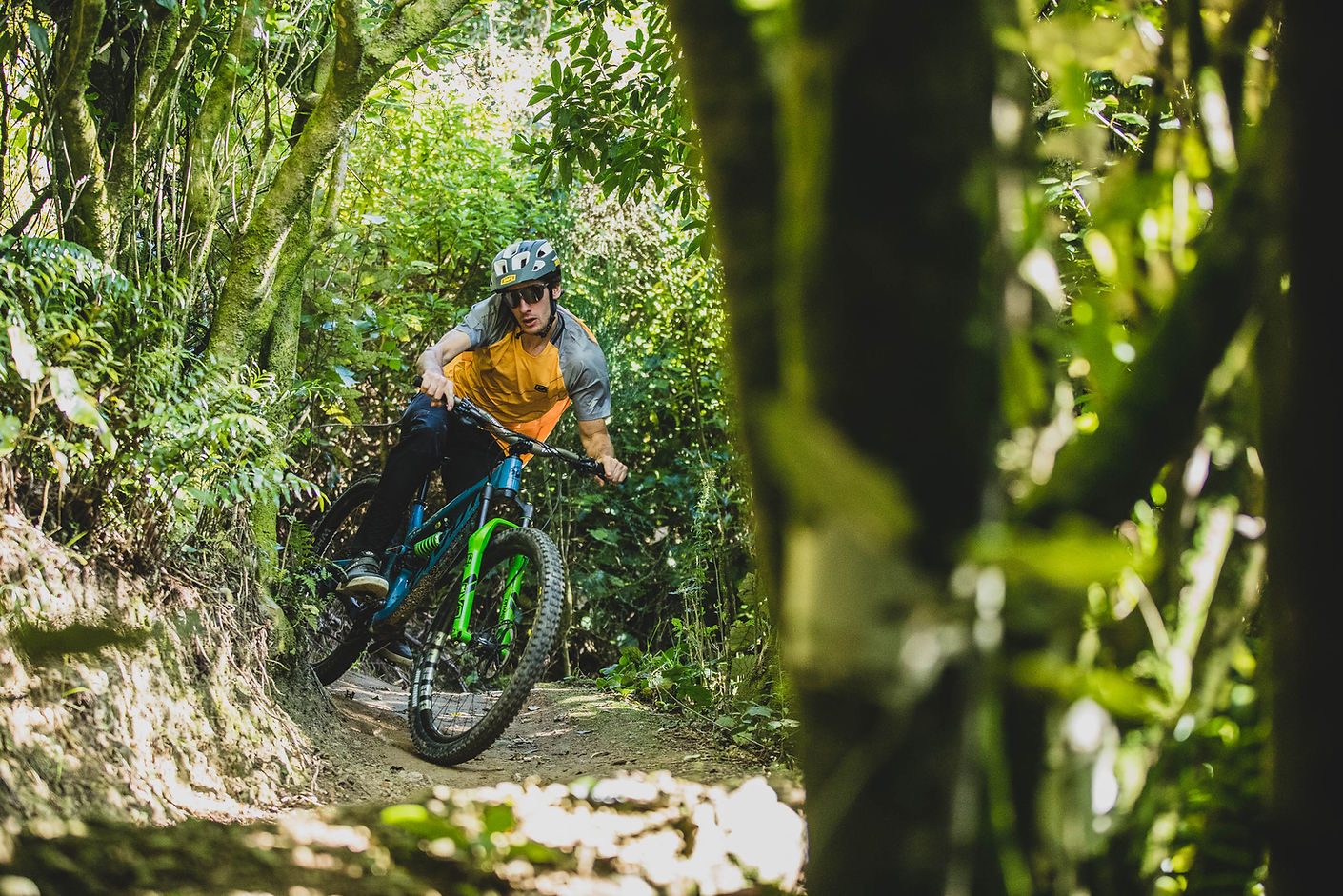
The polished glasses I've been testing came equipped with a mirrored silver lens and a back up clear lens. I have yet to need the clear lens as the mirrored one adapts to changes in light very quickly. The lens has not fogged up, and after many clumsy trail moments there are no marks on the impact resistant Hydroio lens. Initially, I ran them only on mountain bike rides but have since tried them on the road bike and even at a cyclocross race, and found the generous size and shape to keep unwanted air and mud away from my eyes. On the road and trail I've found them to make obstacles appear very sharp, almost enhancing my vision. The addition of ultra-grip rubber on the arms and nose piece meant, once they were where I wanted them, there was no movement whatsoever. I've often seen cyclists with glasses that don’t contrast well with their helmet, however these are not those; I have tested them with five different helmets from varying brands and they look amazing. A couple of times, whilst driving, I have picked them up to block the harsh sun – I’ve also received compliments on how good they look.
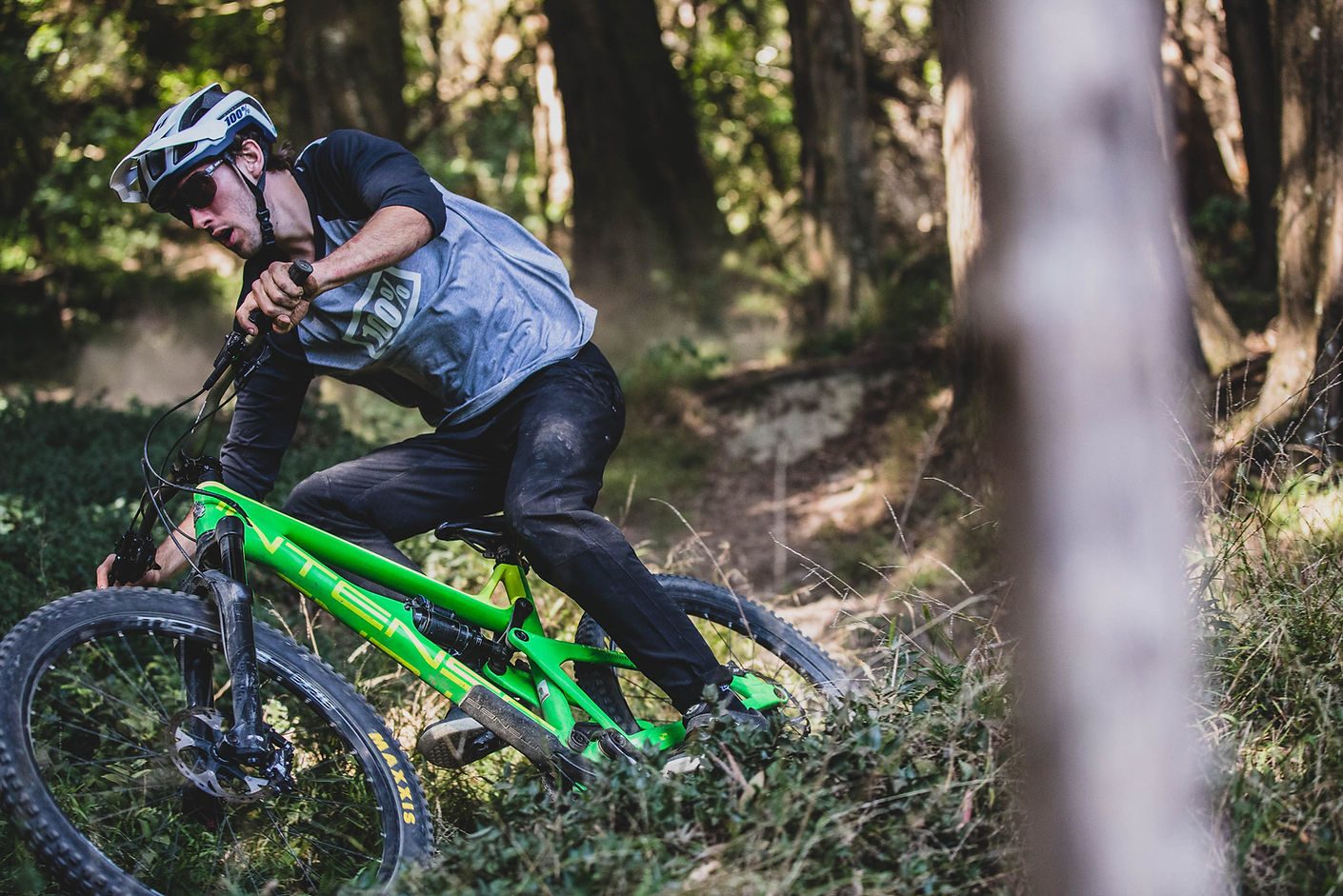
The price tag of $334 seems scary for something you think you may not need, but I can assure you these will up your steeze factor and are a good investment for a durable pair of multi-use glasses. Would I recommend these? Absolutely. If you want to stand out amongst your friends, be a style god, and keep shit out of your eyes, look no further than the 100% S2 shades.
Distributor: FE Sports
Words: Jesse Cseh
Images: Caleb Smith
Review: 100% Teratec Knee Guards
So, as they say, it’s best to use protection?! Nah, you really should, especially when it comes to riding mountain bikes. If you’re like me and fall every so often then you want to protect yourself. So, yea, use protection. 100% have made a real impact on the scene but in years gone by they made simple accessories for MX, nowadays they’re a global player. You can see their googles on the heads of racers but recently they’ve become known and well-established for apparel and helmets. The brand continues to grow, and over the past few months, I’ve had the opportunity of testing some of their protection; Teratec Knee Guards.

The Teratec uses a lightweight design, they’re comfortable in use, and the overall stability of this protector is excellent. It’s got a fairly generous cut with enough sleeve up the top of the pad to ensure it stays in place. The protective pad works as its meant to – soft and flexible allowing for movement but robust enough when you crash on it. I found the guards needed a bit of ‘breaking’ in order to make the material a little more pliable. After the first few rides, they started to fit better. Fit wise, I lean towards a medium and sometimes large but with these, I’d recommend trying before you buy. These do a run a little tighter and for me, the medium was a touch small – this was mainly around the cuff at the top. But that maybe because I’ve got thick thighs?! You be the judge, but some riders may want to size up. That said the elastic/rubber cuffs at the top and bottom do fit very tight, but the pads stay in place well. And throughout all my rides with them, they stayed in place. However, I would like a little more rubber above the knee pad with a touch more roominess if I’m being picky.
In regard to the actual protection, the removable insert is super solid. And I’ve had a couple of offs to thoroughly validate this. There’s good coverage across the entire knee including some of the upper shin. For me, the pads didn’t get overly hot and they’re fine when it’s cold out. After a few rides, they do stench so best to whip the pads out and chuck em’ in the wash with your other riding gear. Having this easy option is a huge bonus and means you keep your riding buddies.
Above all the Teratec Knee Guards do their job well. They’re comfortable to wear all day on the bike and offer good protection and comfort. Wearing them I felt faster. Perhaps I just looked faster or because I had such good protection, I had more confidence to push myself harder.
Words: Liam Friary
Images: Cameron Mackenzie
Review: 100% R-Core X Pant
Riding pants have come a long way since I was a kid. I remember the first set was a grey set of Fox 180 Moto pants I got for Christmas. I thought they were the coolest things ever. I would ride everywhere in them. They were thick, heavy and probably would still be around with the cockroach if the world went up in flames in a nuclear war.
Fast forward to 2021., I may not still own them Fox pants but I still think riding pants are the coolest thing out. Lucky riding pants have come a long way since I was young. We now have a vast range of them out there designed around mountain biking specifically.
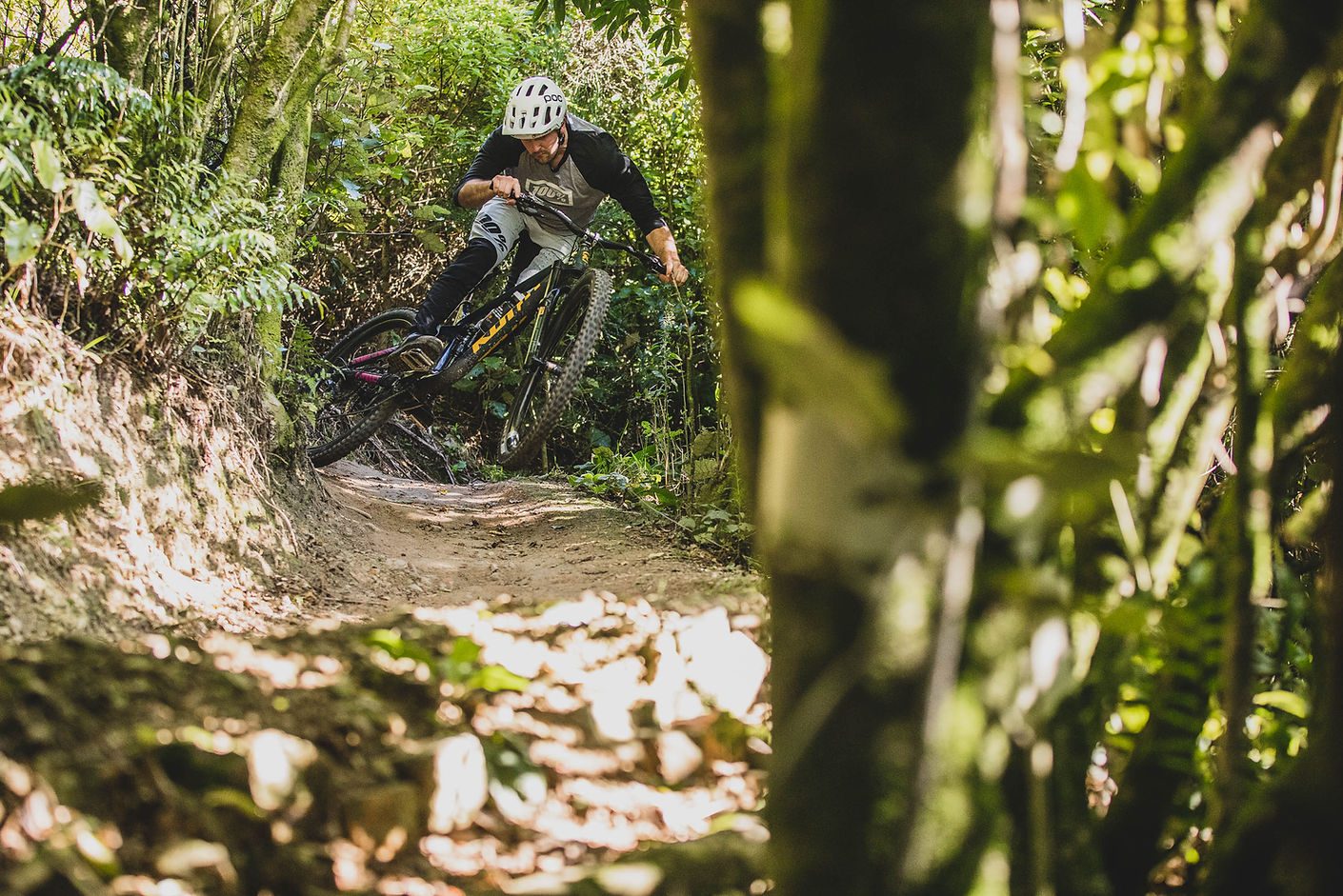
I was lucky enough to be given a set of 100 percent R-Core X pants to test. 100 percent has a rich motocross history dating back to the 1980s but more recently has moved into the mountain bike scene. This history and knowledge show in their products: well-designed features, fit, ventilation and materials.
The R-Core X pants are aimed at the trail enduroish market., They are packed with clever features. The first thing you notice when you put the pants on is just how much airflow they have. There were many times I put them on and thought there I must have put a rip in the crotch purely from the breeze passing through them. Fit wise, they sit in the middle of the range - not too tight and not too baggy, enough room to move and also fit kneepads on underneath. A mixture of four-way stretch spandex and DWR coated polyester provide stretch and strength where you need them most. Silicon gripper pads on the back of the waist help keep the pants up while you do up the fantastic boa on the front. Why don’t more people do this? It makes a lot more sense than buttons or straps. The boa allows for micro-adjustment on the tightness and I personally love the way it looks. Rounding out these pants are two well-placed zip pockets on the front - big enough to get a phone and a small tool in one pocket.
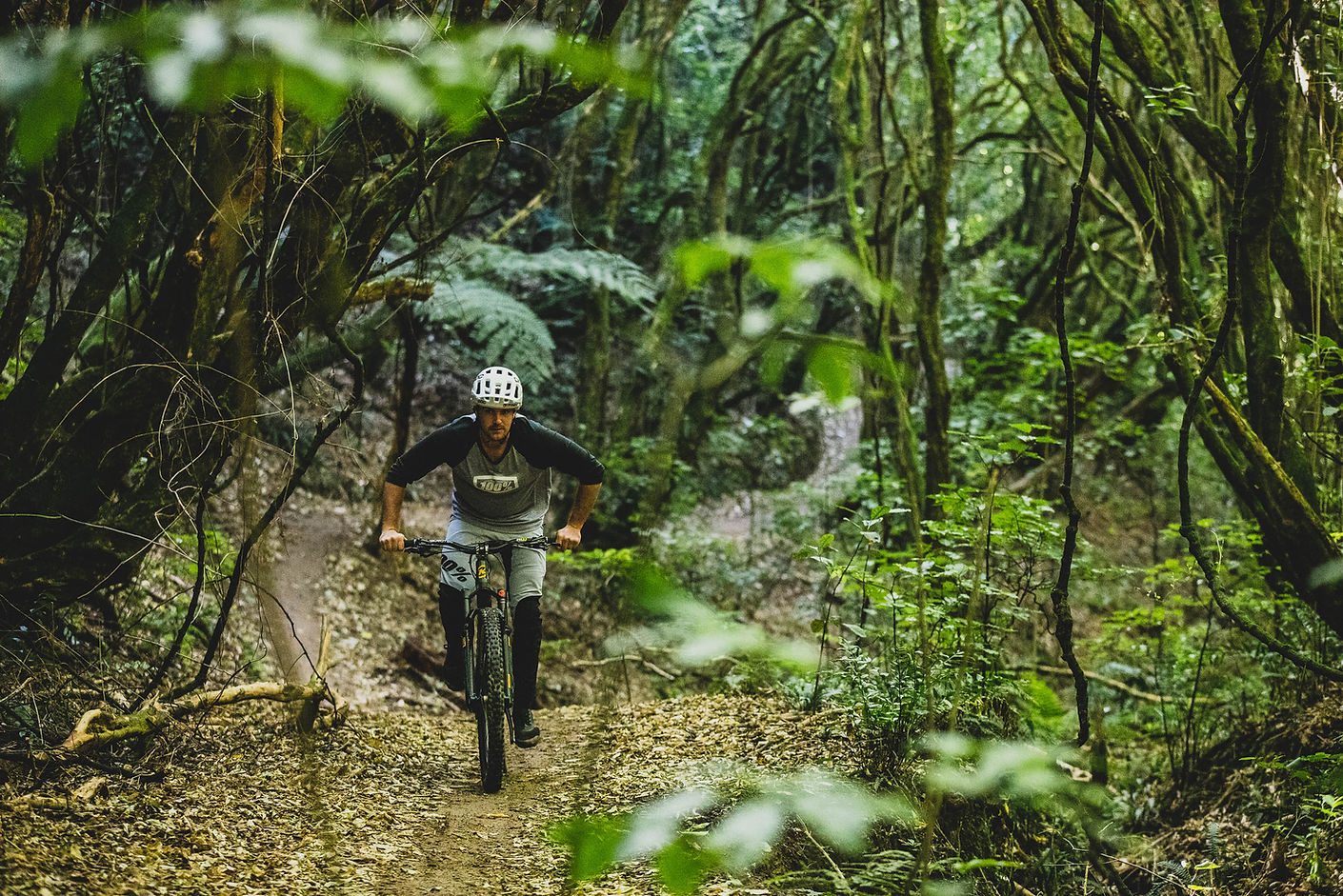
I've spent about a month and a half putting these pants through their paces, from punishing wet rides in the rain to six-hour rides into the bush for overnight missions and quick laps around my local spots. They tend to be the go-to set I grab when I'm heading out riding due to their lightweight feel and overall comfort. All the ventilation helps you not overheat, the fabric stays pretty dry on the wet rides.
What I have noticed on days where it is a bit warmer is that the material used isn't the most breathable. I’d often pull my phone out of my pocket mid-ride and it would be covered in sweat. Not an ideal thing for an electronic device but pop your phone in a sandwich bag before you go riding and you’ll be sweet. Would this put me off buying these pants? Absolutely not. As much as the material might not be the most breathable, the vents keep you cool on warm days. The fit and comfort are fantastic. You almost forget you are wearing them. Fantastic features such as the boa, silicon grippers and vents add up to a great versatile set of durable riding pants that work all year round and won’t let you down.
Distributor: FE Sports
Words: Jake Hood
Images: Caleb Smith
Review: Hunt Wheels
On the Hunt for stock wheel upgrades.
Apologies for the dad joke…. Usually the guide of ‘cheap/fast/good - pick two’ holds true. In the context of that saying, fast means speed of delivery, but in our mountain-biking world we take it to mean fast rolling. No-one seems to have told Hunt Wheels that their budget-minded offerings should make any sacrifice in order to hit price-points though. There’s no denying Hunt’s pricing structure is at the lower end of the range for aftermarket mountain bike wheelsets, but this is not a bad thing when the trade-offs with quality and performance are minimal - perhaps even non-existent.
This review is a little different in that we’re covering two styles of wheelsets - not in a direct head-to-head conflict style, but with the view that both products provide a budget-conscious offering for riders upgrading their stock wheels. The wheelsets in question are the alloy Hunt XC Wide, and the Hunt All Mountain Carbon. Although the XC wheelset is legitimately an option for riders who are all about the climbs (lightweight and relatively narrow by current standards) they’re an equally valid consideration for all-round trail riders who simply want to ride up, down, around and over all sorts of terrain, without a focus on pure climbing performance.

At face value, one wheelset is XC labeled – alloy and lightweight – while the other is trail oriented – carbon with a performance carbon design. What makes these worth speaking about together, really comes down to pricing. For a rider looking to upgrade their stock OEM wheelset of no-name, or house-brand rims and hubs, both these options are feasible considerations. Keep in mind, the XC Wide is only available in 29, while the carbon All Mountain is offered in both 29 and 27.5 guises.
Alloy - modest, but capable of embarrassing much fancier, more expensive offerings. First up, the alloy XC Race Wide wheelset. At $700 including shipping, these are available at a sharp price, largely due to Hunt’s online, direct-to-consumer model, which is increasingly common these days. When ordering online, you choose a SRAM XC, Shimano or Microspline driver. Your wheels arrive with tubeless rim tape and valves installed, along with the driver you specified. You’ll also get four spare spokes, of the correct length, for each wheel/side and a spoke key with inset tool specific to the wheelset. You’ll also receive a couple of stickers for your toolbox, your kid’s lunchbox or the neighbour’s letterbox.


The XC Race Wides utilise 28h front and rear with straight pull spokes. Those spokes benefit by being weight saving, but the downside is that they’re a little tougher to true. Alloy nipples offer a weight saving over brass, but are not my personal favourite as they can eventually round off with repeated truing. These are hard-anodised though, so long-term truing shouldn’t involve too much swearing… hopefully. Their weight, with rim tape and driver mounted (but no valve or discs), is 820g for the rear and 780g for the front - giving a flat 1500g total for the 29er wheelset. That is only 17g off their claimed weight and remarkably lighter than competitors in the same price bracket. If the rider’s goal was to achieve a lighter wheelset than that, it would invariably mean going carbon, at quadruple the price - or more. These are on par with the lightest alloy wheelsets available. In-the-field testing show the wheels hold up reliably on a go-everywhere trail bike, but there are limitations to the nature of narrow, stiff alloy rims.
It is worth noting that the XC Wides use 6069-T6 heat-treated alloy, rather than 6061-T6 some competitors use. 6069 essentially claims to offer significantly greater tensile strength at 60+%. This results in Hunt using less material - and therefore less weight for comparable strength. With regard to rim width, a 2.3 trail tyre, inflated to the same pressure, is 68mm wide on the XC Wide’s 24mm I.D. rim, compared to the same tyres’ 70mm inflated width on a 28mm I.D. rim. There is a difference and it is noticeable, but it’s not night and day. Hunt recommend 2.1 to 2.35 tyres. I ran 2.0s and 2.4s because I like to push the boundaries of what I’m told to do. Somewhat predictably, I ended up running 2.3s which felt the most natural, given the rim’s width. Strike one for the rebel spirit. The mounting of all tubeless was painless, with a modest home garage floor-pump set up.
Hunt’s six pawl rear hub, with 72 engagement points, sounds appropriately refined when freewheeling.
In practice, the alloy XC Wides are fantastic - and average, and sub-par! Any review of a product is influenced by the point of reference - what the product is being compared with and measured against, as well as the rider’s intent on how it should be used. If pitching the XC Wides against competitors of far higher cost, of course they’re not quite going to measure up in performance. Likewise, measuring them against any quality carbon wheelset - as we’re about to do here with their trail carbon brethren - is an unbalanced comparison. But, compare them to stock wheels - that come equipped on otherwise capable trail bikes - and we’re talking real improvements, both in terms of weight, long-lasting quality and riding performance. It’s for this reason we’re showcasing the XC Wides as a valid trail bike option, not just a niche XC-racing only product.
It’s not all roses though. The nature of narrow-ish alloy wheels is relatively abrupt tyre profiles (comparing the same sized tyres on wider rims) leading to sudden release of traction when cornering aggressively, and harsher lateral ‘feel’ on choppy terrain. Those couple of millimetres that the Vernier calipers show in inflated tyre width, are negligible on paper but noticeable in use. The feel is difficult, if not impossible, to quantify - apart from relying on anecdotal feedback about how it feels compared to other wheelset options, on sections of trail I know like the back of my hand. They’re just a bit harsh, pinging off deflections of trail surface. It’s an incredibly fine line, but an observable one if you’ve experienced other options. This serves to segue into our feedback on the Hunt Carbon All Mountain wheelset.
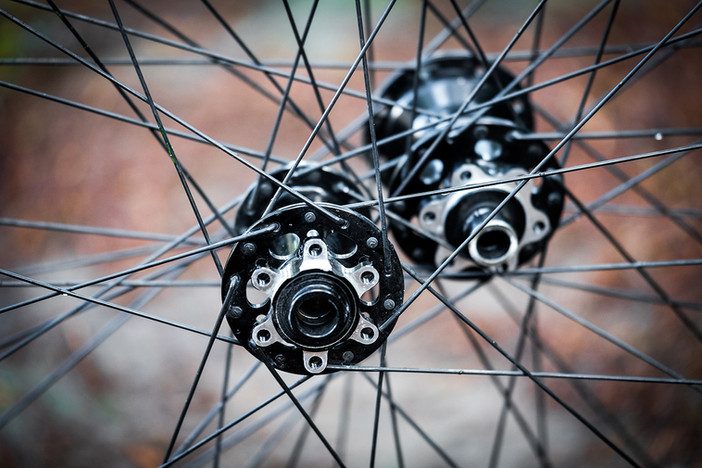
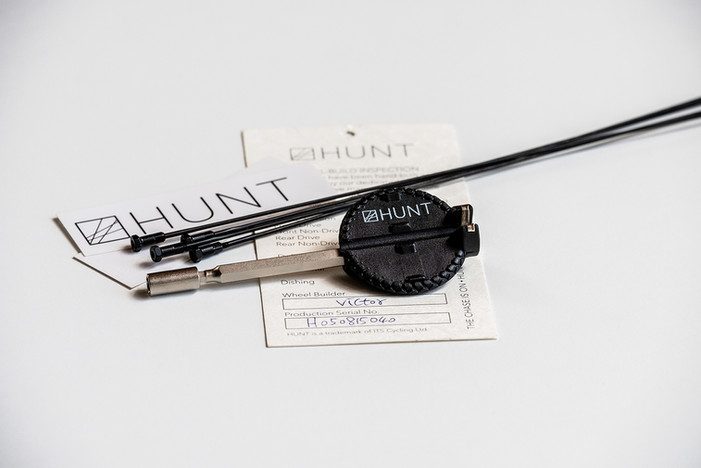
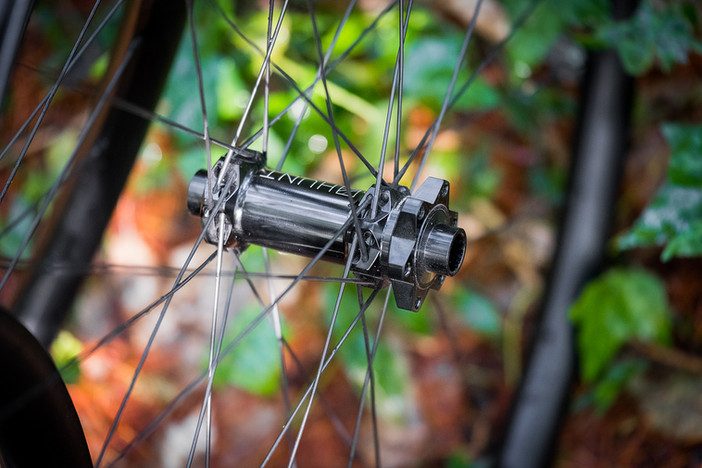
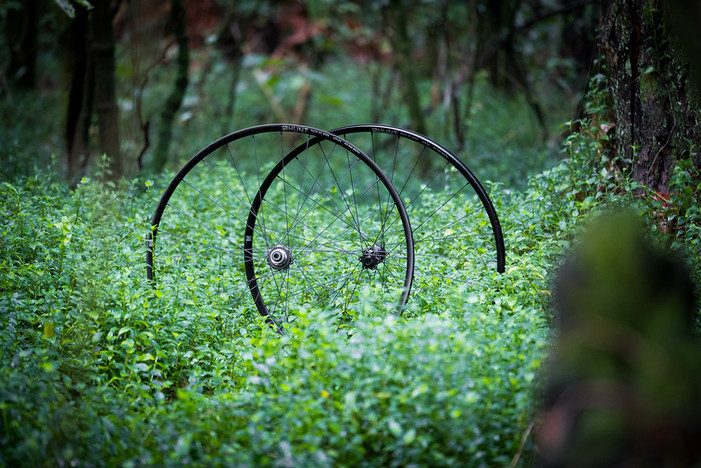
Carbon - done right. This is maximum performance without extravagant brand packaging. The price of these is double that of Hunt’s alloy XC Wides. The performance, however, is not double, but is considerable. It’s a prime example of the benefit of diminishing returns. Improvements are evident, but not by the multiples of dollar value. For those who don’t demand the most performance - and its corresponding price-tag - or who value light weight with an emphasis on the benefits it offers, the XC Wides should be high on their list of considerations.
Back to the Carbons… for those with higher expectations of their wheels, and the budget to suit, the All Mountain Carbons have a lot to offer. Overall, the Hunt Carbons have the following characteristics (they’re pitched as ‘features’, but some of them are only features if they are important to you). POE (Points of Engagement) of the freewheel are a case in point. On one hand, the three-degree POE means you have minimal delay in the feeling of getting on the gas. Also, they make a high-tech buzzy sound without being ridiculously loud, like the swarm-of-wasps some of their premium brand competitors seem to be aiming for with their acoustics. It’s nice to have the instant-on kind of pickup, but not really a game changer for a general trail rider. If you’re riding very technical pedalling sections that benefit from trail-like pedalling responsiveness, then sure, it’s a feature. But that’s about 0.1% of the trail riders I’ve ever encountered. Like their alloy stablemates, tubeless tyres mount up easily with a reasonably tight fit in the Carbon rim’s channels. I’d far rather put in a little more effort getting the bead over the rim initially, with subsequently fast and easy inflation/mounting, than having tyres mount up easily then need finessing to fit correctly.
At around $1600 including shipping, they are way sharper priced than their big-name brand competitors. That is not at the expense of performance - I can categorically say their performance is high. My initial rides were as I always approach review items: completely cold, meaning I hadn’t sought out online reviews or any other feedback from my riding buddies or industry friends. Instead, I rode them purely with a blank slate, on trails I know well, to form impressions of their characteristics. I’m no Rainman, but I can tell a good product from a not-so-good one pretty quickly. Part of not being a Rainman, is being analytical enough to hopefully string together some coherent sentences to convey that intangible ‘feel’ – the way a product affects a ride experience.
Before the subjective ride impression, there were a few factors to consider: conventional ‘J’ spokes in a 32 spoke rear and 28 spoke front format are a little more user-friendly than straight-pulls for truing, in the long term. This isn’t a factor in the early years of a wheelset’s life, but for good quality wheels that stick around to see the comings and goings of multiple frames through a rider’s garage, simple details like this eventually become apparent. The weight of our review Carbons, with rim tape and driver in place but no valves or discs, comes in at 1120g for the rear and 820g for the front (1940g total) against the claimed 1878g. The weight of the rear reflects the heavier rear hub and more spokes, of course, but also the heavier rim layup - built for longevity. The weight of the front rim is not the primary thing of interest - that would be the way the front rim handles. Before covering the front though, the back is worth speaking about a little more. Well, kind of – it’s a bit boring. It’s simply rock solid. Our testing took it from varieties of rock-layered South Island trails to high speed, native bush single-tracks in the Central North Island - with their resident sniper roots ready to surprise any unsuspecting rider with a gut-wrenching thump at high speed, when least expected.

Apart from the 28 spoke front and 32 spoke front format, there is a great deal more going on with the rims. Hunt’s focus on purposeful front and rear specific wheel characteristics, is largely down to their rims. With both rims using carbon laid up specifically for their purpose, the rear is essentially stronger and stiffer. It doesn’t have any particular ‘feel’ when riding, apart from being solid when loading up the rear end on high-speed corner exits. It also offers a great deal of confidence with its ability to suck up the occasional case of coming up short on a double jump - or unexpected slam through a rock garden with a muted ‘thunk’ - rather than the dinner-bell ringing ‘gong’ that alloy rims offer.
The front is where the magic happens, though. Like a few of its prestigious high-dollar competitors, the Hunt’s front rim is lighter, with a lower material density lay-up. It sounds like a real estate agent wrote the marketing copy when brands start talking about improved compliance and better grip due to a rim/wheel. Obviously the tyre has a massive influence on those features, but I couldn’t honestly say I felt any particular difference in front wheel/rim flex, or compliance, when riding these wheels. What I can say, is the front end feels more forgiving. Not necessarily a marked difference in the feeling of grip, but definitely the feeling of having a fraction more control over where the front end is pointing and tracking. It’s especially noticeable at the edges of rider ability - the feeling of being able to point-and-shoot, almost like time slowing slightly so that you’re in complete control of where you’re aiming, even while you’re riding at the razor edge of your ability. That’s the primary reason why these wheels punch well above their weight, given the price-point they’re offered at. Sure, the POE and quality hubs are great, and the lifetime crash replacement for the first owner is awesome, but it’s that front rim with the corresponding wheel-building format, with spokes/lacing specific to front and rear, that lifts them to another level. As said before; the difference is not night and day, but is noticeable nonetheless, especially when pushing the boundaries.
As a final detail, they’re available with oil slick spoke colours at a premium price. Pretty, but with no performance impact. If this kind of thing floats your boat - choice, go for it. There is nothing wrong with paying a little more to make your bike look how you want it to.
Overall
If your focus is grounded on bang-for-your-buck and how wheels can change your bike for the better, either set of Hunts are a solid contender for anyone upgrading from stock wheels. Depending on the value of your bike, and your intentions, either could be a smart way to spend money on improving the quality and durability of your bike’s performance. Of course, the carbons are better - get them if you can afford them, and your riding will take advantage of them - but don’t discount the XC Race Wides. For the money, they’re a viable upgrade for many riders. Hunt have managed to hit the fabled three - which shouldn’t be possible - with ‘cheap, fast and good’ being an apt description for these offerings.
Distributor: Hunt Wheels
Words and Images: Nick Lambert
Review: 100% Airmatic Pants
100% has always been a brand heavily correlated to American motocross racing, producing top of the line apparel, products and racing equipment for riders on the track. Over the past few years, 100% have expanded their range to incorporate products for everyday mountain bikers, like myself. The new Airmatic pant is a welcome addition to their ever-expanding array of mountain biking product. This pant has you covered through any conditions the trail wants to throw at you. 100% have combined the fitment of their popular R-Core-X pant with the 4-way stretch material and the reliable, mountaineering buckle system featured on the Airmatic Short. This new Airmatic pant promises to deliver warmth, flexibility, ventilation and most importantly comfort.
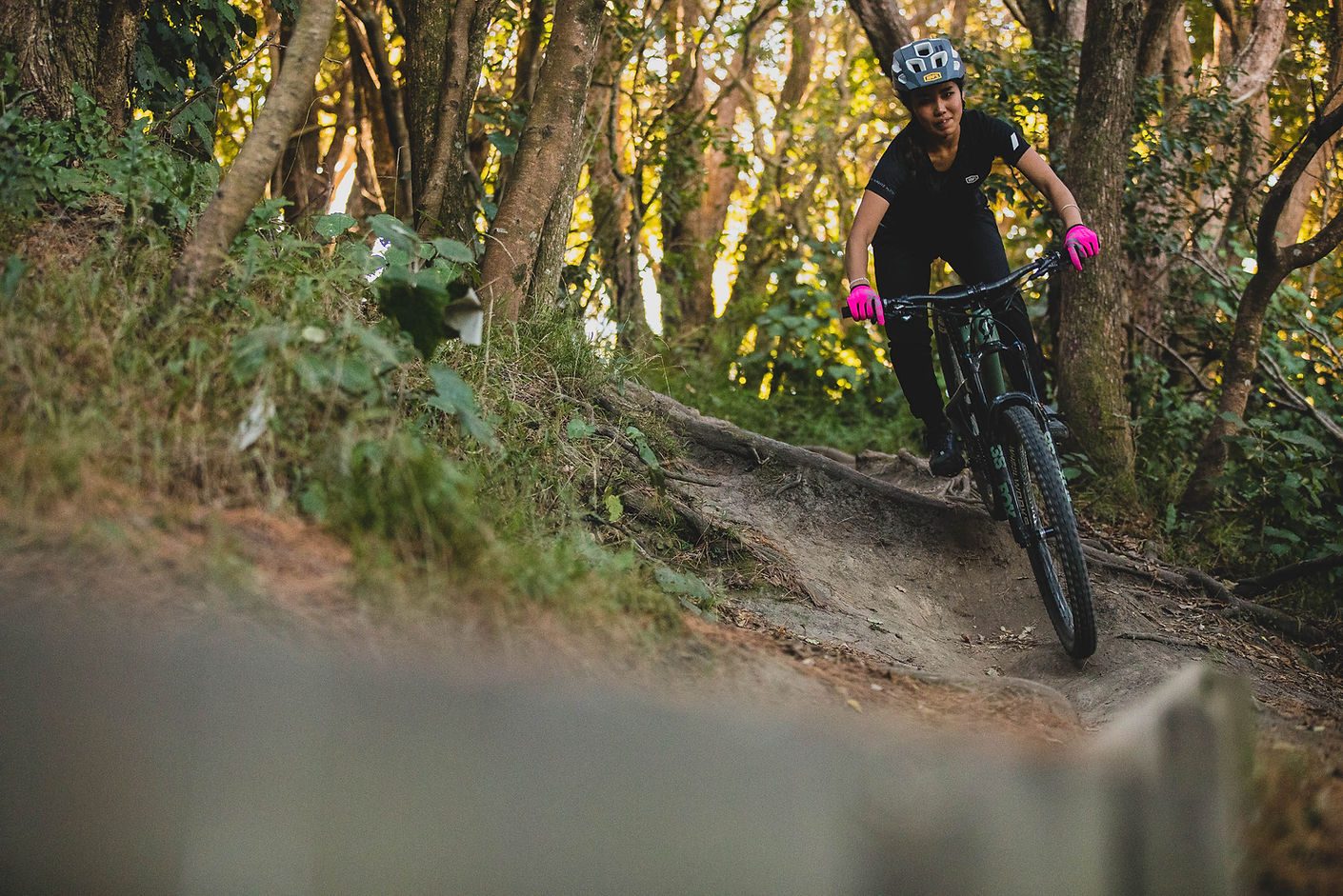
Personally, I’ve found it challenging to find the perfect pair of riding shorts that are comfortable and also flattering. I’d never considered riding pants to be an option, as I have always opted for the classic short and knee pad combo. However, the 100% Airmatic pants have been a total game-changer. With a tapered leg cut, a hassle-free adjustable belt latch and two zippered pockets on each side, the pants are my new go-to for trail riding. Both side pockets were large enough to fit my phone, with an inner mesh pocket to hold your phone in place when riding, barely noticing the phone when pedalling. Bonus!
Made of four-way stretch material, the pants are lightweight, pliant and have proven to be incredibly comfortable and pedal-friendly. At first ride, I was sceptical of how lightweight the pants were and whether they would be prone to ripping, however, they proved to be super durable having survived a couple of crash tests without tearing, proving the fabric to be tough and reliable.
The Airmatic pants play well with knee pads, fitting under the pants comfortably, whilst still offering the right amount of stretch without feeling restricted in your movements. However, I found that there wasn’t an awful amount of stretch or adjustment in the waistband, as the pants don’t have adjustable velcro on the sides as most riding shorts and pants have. This just means that you must buy the pants true to size.
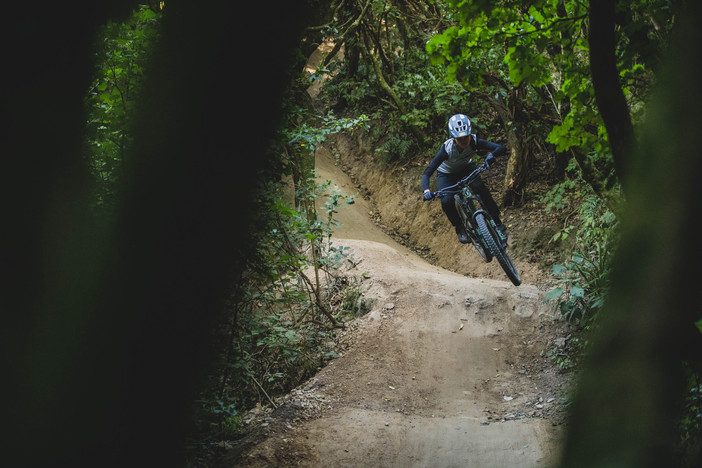
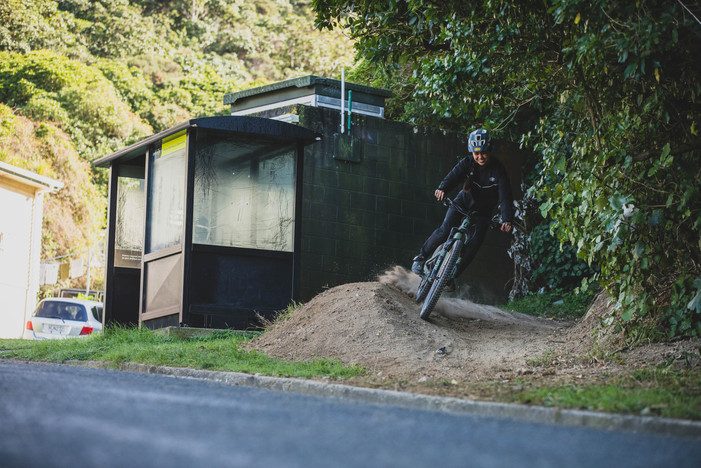
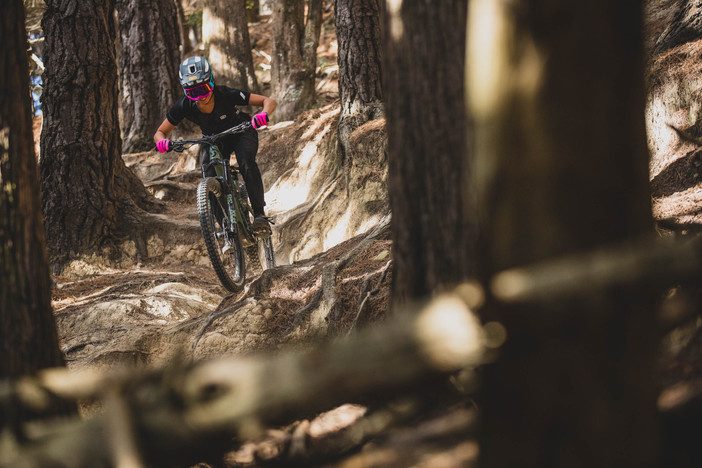
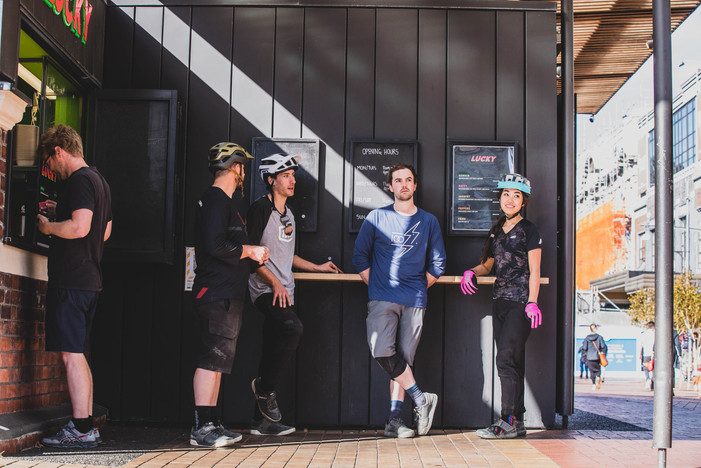


Overall, the 100% Airmatic pants are functional and fitting. The tapered cut of the pants keeps cuffs out of drivetrains whilst earning major points in the style department. They up my swagger game when I’m rocking them, well at least that’s what I think?! And, I’ve found them to be a comfortable and fly-looking pair of pants off the bike too whilst doing repairs on my bike or grabbing a craft beer at the local bar. The Airmatic pants are definitely good all-rounder pants, rain or shine and have so far, kept the chill off the autumn Wellington wind.
Distributor: FE Sports
Words: Khulan Tumen
Images: Caleb Smith
Review: Jetboil Flash
I always saw a Jetboil as a ‘nice to have’, never a necessity. Nothing was wrong with my tried and true billy and cooker - hell, it even had character - but when I saw my mate pull a Jetboil out of his pack on a recent adventure, ‘nice to have’ became need. The Jetboil completely rethinks how a camp cooker works. It still utilises the same gas canister and burner arrangement, but features new tech in the bottom of the pot, using FluxRing – which has a similar appearance to honeycomb - to create more surface area, allowing for much more heat dissipation. In turn, this equals lightning-fast boiling and greater heat control.

I’ll admit, I thought the whole concept was a little gimmicky at first, but upon using the Flash for the first time myself, I quickly understood what it was all about. Using the Jetboil is straightforward, and it’s clear the integration and usability has been well thought out. The whole unit; gas canister, stand, burner and cup, all pack inside the main flask for easy transportation. Say goodbye to wet matches or a broken lighter, because this burner has push-button ignition.
Using the Jetboil
Using the Jetboil is straightforward. After you’ve got the hang of the setup and breakdown process, using it in the field is simple. The base assembles easily by threading the burner and gas canister together then clipping the stand on - make sure you do this in a well ventilated area as it does hiss a little bit of gas. The flask and burner slide together and create a secure fitting which leaves you feeling assured that no matter how delirious you are after your day’s effort, you won’t knock two cups of boiling water over yourself without trying really hard.
It will surprise you how quickly it brings water to the boil, but the neoprene sleeve on the flask has a brilliant, built-in temperature gauge that ascends in an orange color to show you how close to boiling it is. My suggestion is to leave the vented lid on while bringing ingredients to the boil, as it can spill over very quickly and make turning the heat down very difficult. I learnt that out the hard way...
Is it worth the money and is it right for me?
If all you’re only eating freeze-dried meals or drinking hot beverages while out in remote areas, then this is all you need. If you’re looking to cook or fry food, then the addition of their traditional pot holder and a conventional pot/billy would be better suited. Either way, the Jetboil flash system is all I will be taking with me from now on, for speed, portability and ease of use.
Words & Image: Cameron Mackenzie



